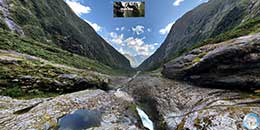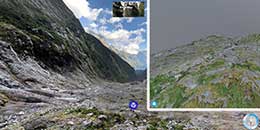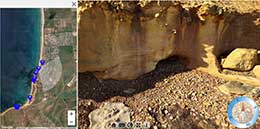31 October 2018
 The University of South Australia will develop a new immersive virtual reality (VR) education and outreach program for the Australian minerals industry to help to attract the best and brightest to the sector.
The University of South Australia will develop a new immersive virtual reality (VR) education and outreach program for the Australian minerals industry to help to attract the best and brightest to the sector.
Project LIVE-MM (Learning through Immersive Virtual Environments for Minerals and Mining) will create interactive virtual reality experiences to allow students to “become a geologist for a day”, using the power of VR to provide an insider’s view of geoscience in action and serve as a launching pad for future careers.
A team from UniSA will develop the platform over the next two years, led by UniSA’s Program Director of Environmental Science and Geospatial Science Associate Professor Tom Raimondo.
 Assoc Prof Raimondo notes the synergy between Project LIVE-MM and the recently announced MinEx CRC, a $215-million minerals industry joint research project to be led by UniSA’s Professor David Giles and co-located at UniSA.
Assoc Prof Raimondo notes the synergy between Project LIVE-MM and the recently announced MinEx CRC, a $215-million minerals industry joint research project to be led by UniSA’s Professor David Giles and co-located at UniSA.
“The MinEX CRC will effectively act as a research arm for the mineral exploration industry, so not only will UniSA be leading the research that will drive the future of this industry, with these VR modules we're also doing the outreach it depends on to attract the best talent,” Assoc Prof Raimondo says.
With $100,000 funding support from the Australasian Institute of Mining and Metallurgy Tomorrow’s Professionals Program, the focus of Project LIVE-MM will be to capture key field sites and activities that convey core minerals industry skills and capabilities – from developing fundamental geological knowledge and its application, to innovative research studies and their use in revealing the subsurface, to demonstrations of new technologies and how they are employed in authentic scenarios.
 Project LIVE-MM will extend UniSA’s successful virtual reality initiative, Project LIVE (www.projectLIVE.org.au), a cross-disciplinary program that uses immersive visualisation technologies to create engaging experiential learning exercises, and Assoc Prof Raimondo says the experiences developed for the new project will be at the cutting edge of the field.
Project LIVE-MM will extend UniSA’s successful virtual reality initiative, Project LIVE (www.projectLIVE.org.au), a cross-disciplinary program that uses immersive visualisation technologies to create engaging experiential learning exercises, and Assoc Prof Raimondo says the experiences developed for the new project will be at the cutting edge of the field.
“People will be able to interact with 3D models to achieve a particular goal, progressively unpacking the information provided to make sense of it,” he says.
“So, it will function like a series of mini games or tasks within the virtual environment, rather than a passive learning experience that is a bit like a documentary.”
Highly instructive field sites are often situated in inaccessible or remote locations where training visits are impractical or cost-prohibitive, and recent advances in virtual and augmented reality have meant these sites can be captured and shared in a way that immerses students, researchers and others in the field environment.
Digital visualisation is achieved through a suite of technologies including Remotely Piloted Aircraft (drone) surveying, 3D photogrammetry, gigapixel photography, terrestrial laser scanning (LiDAR), 360-degree panoramic photos and videos, augmented reality apps and VR headsets.
“These modules will give students a critical first impression of the industry that is both fun and stimulating and interactive, and the program will provide early exposure to digitally-enriched learning and technologies that are already being used in professional practice,” Assoc Prof Raimondo says.
Interview: Assoc Prof Tom Raimondooffice (08) 8302 6661 email Tom.Raimondo@unisa.edu.au
Media: Dan Lander office (08) 8302 0578 mobile:0416 760 162 email dan.lander@unisa.edu.au


